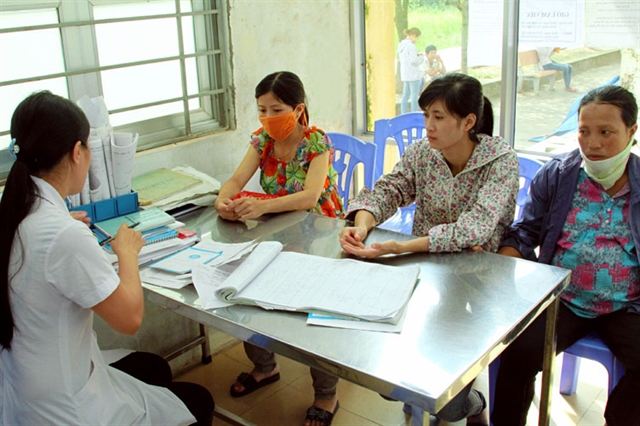 Society
Society

In the first nine months of this year, the sex ratio at birth in Ha Noi stood at 110.5 boys to 100 girls, a decrease from 2018 when it was 113.5:100.

|
| Women receive advice on reproductive health from a doctor at the General Hospital in Mê Linh District. — Photo hanoimoi.com.vn |
HÀ NỘI In the first nine months of this year, the sex ratio at birth in Hà Nội stood at 110.5 boys to 100 girls, a decrease from 2018 when it was 113.5:100.
The city welcomed more than 78,350 newborns in the first nine months of the year, an increase of 3,935 children over the same period last year. Among them, 6,136 were at least the third child in their families, rising by 254 compared to the previous year.
Gender inequality was falling but the third-child birthrate had shown an increase, said Tạ Quang Huy, the director of the municipal Department of Population and Family Planning.
Districts with high birthrates included Hoàng Mai, Đông Anh, Hoài Đức and Cầu Giấy.
The country's basic policy encourages parents to have two children per family.
With a long-standing cultural preference for boys, couples who have only daughters always want a son because many believe that only sons can be responsible for worshipping their ancestors and maintaining lineage.
In fact, many Vietnamese families want to have more children, especially due to better economic conditions, so they decide to have a third child.
In many cases, these families are cadres or civil servants who are familiar with the State’s policies and laws.
Nguyễn Thế Mạnh (not his real name), 59, a construction engineer from Hà Nội’s Ba Đình District, said he was very happy when he had a son.
“I have three daughters already. But I still want to have more children and especially a son. Seven years ago, my wife gave birth to our fourth child at the age of 47, and I was so happy because it was a boy,” Mạnh said.
“I was demoted in my job but it did not make me sad. I had the son I wished for.”
The third child ratio was a problem as the city was looking to maintain a reasonably low birth rate and control the gender ratio at birth, according to Huy.
Dr Nguyễn Đình Cử, former director of the Population and Social Affairs Institute at the National Economics University, said for a long time, people thought that the imbalanced sex ratio at birth was mainly due to poor and uneducated mothers, but in fact, this is not true.
Many rich families and well educated parents found out the sex of the babies while the mothers were pregnant and decided whether to continue the pregnancy depending on the results, generally meaning they were hoping for a boy, according to Cử.
Hà Nội Mới (New Hà Nội) newspaper reported that recent census results conducted by the General Department of Population and Family Planning at the Ministry of Health showed the lowest sex ratio at birth among illiterate mothers was about 107 boys per 100 girls.
This rate gradually increases to 114 boys per 100 girls among more educated mothers. In rich families, the sex ratio at birth is 112:100, while the rate in poor families is 105:100.
The surveys also showed the gender imbalance particularly increases among families with a third child.
For the first birth, the sex ratio is 109.7:100, while this rate rises to 111.9:100 for the second birth. But at the third birth, the sex ratio stands at 119.7:100.
Although appreciating the achievements of the city's population and family planning efforts over the years, Dr Hoàng Đức Hạnh, deputy director of Hà Nội's Health Department, said it was necessary to continue implementing measures to control the gender imbalance, particularly the third-child birthrate.
Raising awareness of the problem and changing public attitudes was also needed to ensure families only had two children, he said.
Supervision at all levels regarding the sex selection at health facilities, especially non-public health facilities, should also be strengthened.
The municipal Department of Population and Family Planning would continue to focus on communication campaigns, counselling and direct dialogue with couples of reproductive age, while supplying contraceptives, according to Huy.
The steering committee for population and family planning in districts and towns would also strengthen supervision in localities with a high rate of third child births.
Nguyễn Thị Ngọc Lan, deputy director general of the General Department of Population and Family Planning, said that a key solution to preventing the gender imbalance at birth was to promote gender equality and women's empowerment as well as men's participation in gender equality.
In particular, actions were needed to show children they are equal, whether they are boys or girls. VNS




